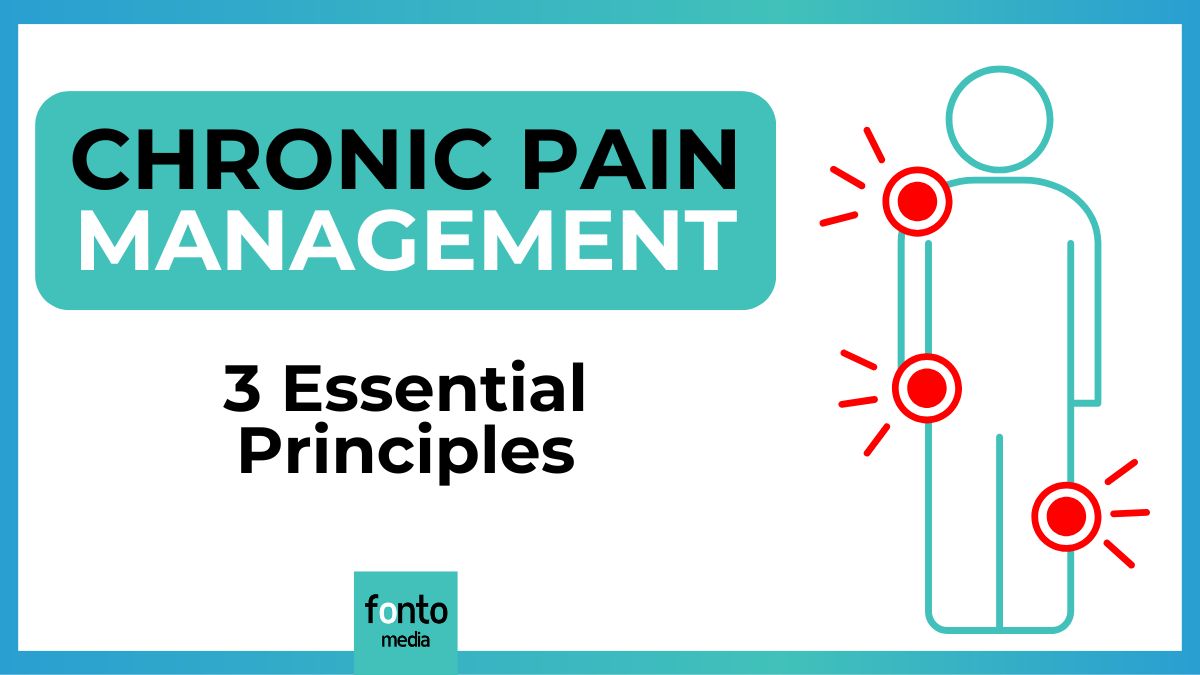You live with chronic pain. You’ re struggling to find a truly effective treatment– one that will permanently eliminate your pain.
Perhapsyou’ve evengiven up on the idea after so many fruitless searches.
Whether or not to continue looking for a miracle cure, that’s the question.
I don’t propose an answer to this question. That’s for you to decide.
Either way, your pain is there, and you have no choice but to deal with it.
And if you’re reading this, it’s because you’ve decided to include information seeking in your pain management strategy.
A wise decision! Keep up the good work by reading this article.
♻️ Last updated: August 20, 2025. Written by Nelly Darbois.
👨⚖️ Declaration of financial interests: none directly related to the subject.
What is chronic pain?
Whatever the reason, when pain persists for more than 3 months, it is customary to speak of chronic pain [1]. Chronic pain is contrasted with acute pain, which lasts less than 3 months.
Admittedly, this criterion of duration and the expression “chronic pain” are of dubious utility [1]. In fact, they say nothing about the most important thing: the cause of the pain and its treatment.
In practice, describing pain as “chronic” means more than simply noting how long it lasts. It also means acknowledging our inability to explain and treat it properly.
But what exactly is “proper” pain management? Let’s consider this question for a moment. The answer we each give to this question has very concrete consequences.
(Note: identifying the main cause of persistent pain is often very difficult indeed. See, for example, persistent pain after an ankle sprain.)
Examples of chronic pain :
Chronic pain treatment: what are we talking about?
I’m sure each and every one of you can describe with ease what the ideal treatment for your pain looks like. I’d wager that it meets at least the following three criteria:
- it completely and permanently eliminates your pain;
- it carries no risk of side effects;
- it costs nothing.
In short, it’s the miracle cure. If you’re reading this article, you either haven’t found such a treatment yet, or you’ve given up on it altogether.
So you may have fallen back on the search for a treatment that’s only satisfactory if not a panacea. You may have set out in search of a remedy that :
- relieves your pain satisfactorily and for long enough;
- carries an acceptable risk of side effects;
- is available at a reasonable price.
“Satisfactory treatment”, “acceptable risk”, “reasonable price”: judging what is satisfactory, acceptable or reasonable is a personal matter. That’s why it’s impossible for a third party to determine in advance what a good treatment might be for you. This is impossible without knowing your pain management goals.
As we shall see, setting your goals is an essential step in implementing good pain management.
From treatment to management of chronic pain
What’s the difference between treating your pain and managing it? An interesting way of approaching this question is to start with the problem you are facing:
- you have pain for which no one can offer you a miracle cure;
- As a result, you probably settle for imperfect treatments that satisfy you at least a little (for example, taking painkillers);
- As the result of these treatments is imperfect, you have to live with residual pain.
Everything you put in place to deal with these persistent residual pains is what I call pain management.
Some people are better at managing their pain than others [2]. This has led many health practitioners and researchers to ask: is it possible to identify techniques for managing pain that are more effective than others? If so, can these techniques be taught? Candidate techniques include :
- Balance your activities;
- Regular physical exercise;
- Setting smart goals;
- Practice relaxation or meditation;
- Proper use of medications;
- Managing your sleep.
There are many others. You’ve probably already used one or more of these techniques yourself. The question now is: does it work?
Learning to manage pain:does it work?
In the next part of this article, I present 3 principles that I believe are fundamental to pain management. But first, I’d like to answer the following question: do the pain management methods commonly taughtwork? Do they really have a positive effect?
The “positive effect” of a pain management method can mean :
- reduces pain;
- reduces pain-related movement difficulties (“disabilities”);
- eases the emotional distress associated with pain.
To date, the results of studies have been disappointing. The most widely evaluated group of methods (the so-called “cognitive-behavioral” methods) has shown little or no efficacy [3].
There was also little evidence of effectiveness for other, less evaluated methods [4].
Please note, however, that these results relate to a typical category of chronic pain sufferers. However, the person reading this is not a typical sufferer. You’re a person who has chosen to find out about pain management on your own. So you’re probably someone who takes an active approach overall.
With this in mind, I’d like to suggest 3 principles to help you structure your own pain management approach.
Three principles to improve your pain management
I am going to propose and detail three principles to improve your pain management:
- methodically assess the consequences of pain:functional assessment;
- set smart goals;
- document your functional self-assessment, your objectives and the follow-up of their achievement.
Assessing the consequences of your pain: functional evaluation
To live as well as possible with pain, it’ s crucial to assess its impact on your daily life in detail. What does this mean? Here are some important questions to ask yourself:
- Does it hurt to rest? In other words, does it hurt when I’m not doing anything? Sitting? Standing? Lying down? If so, is the pain constant, or does it only come on after a while?
- Does the pain prevent me from sleeping? If so, is it the pain that wakes me up? Or does it only bother me once I’m awake at night for another reason? Does it prevent me from falling asleep or going back to sleep?
- Which activities hurt the most? Exactly which movements?
- What everyday activities have I had to stop completely because of my pain? Which activities are only partially hindered (for example, you can still walk to buy bread, but with a crutch)?
- For each of the above questions, we can also ask :
- is it systematic? For example, if the pain makes it hard for you to sleep, is it something that happens every night or just once in a while? If it’s occasional, how often exactly?
- Is it really pain, or is it more a kind of discomfort or unpleasant sensation (pressure, pulling, etc.)?
- How would you rate your pain on a scale from 0 (no pain at all) to 10 (the worst pain you’ve ever felt)?
The purpose of asking such questions is to enable you to :
- identify the main impact of your pain on your daily life. This will help you set intelligent pain management goals.
- Highlight all the aspects of your life that are not affected by pain. This can help you feel positive.
- To accurately monitor your pain and its evolution, from bad to better. This can help you assess the effectiveness or ineffectiveness of your pain management strategy.
- To help you find the most appropriate solutions for managing your pain (and to steer you away from unnecessary or even harmful solutions).
To illustrate the importance of this functional assessment, I’ll tell you an authentic clinical anecdote.
Stop pressing!
Mr X: “Doctor, I think it’s serious. All over my body, wherever I press with my index finger, it hurts. What’s wrong, Doctor? What should I do?” Doctor Y: “Start by stopping pressing everywhere, I think you’ve got a broken finger.”
Of course, this is just a joke. However, I think you’ll see the family resemblance with the authentic anecdote that follows.
This was someone I was caring for following cruciate ligament surgery. At the beginning of the treatment, the patient asked me if I could also take care of an old pain in her left ankle.
A few sessions later, just as her general condition and knee capabilities were improving, the person pressed me: “Say, you said you’d take care of my ankle too, and you still haven’t looked!”
Mea culpa. I hadn’t really thought about his ankle yet. I comply, and start asking her about the impact of her pain on her daily life. In other words, I begin to conduct a functional assessment of her pain.
So I asked him a whole bunch of questions, of the kind I’d outlined above. To my astonishment, the pain seemed to have absolutely no effect on her daily activities. She told me it didn’t hurt when she rested, it didn’t hurt at night, it didn’t hurt when she walked, it didn’t hurt during her leisure activities, and so on. So much so that I ended up asking her: “But Madame, when exactly do you actually feel pain? She replied:
“Well, you see, when I press here on my left ankle, it hurts, whereas when I press in exactly the same place on my right ankle, it doesn’t hurt at all. I’ve been under the care of a physiotherapist for 3 years now. And I’m glad I did, because the problem hasn’t got any worse!
…
Now, I’d like you to take a few moments to think about and answer the following question: what do you think we should recommend to this person to relieve their pain?
…
Answer: stop pressing on your right ankle!
…
This answer may seem like common sense to you. Some of you may feel that this patient wasn’t particularly clever not to have thought of it before. But the reality is different. As it turned out, this person wasn’t really suffering from ankle pain. The pain wasn’t the problem. No, what worried the patient was the fear that this pain was a sign of a problem that could worsen over time.
Is this kind of fear justified? No, there’s absolutely no reason to worry about isolated pain on palpation, whatever the area of the body concerned. Problem solved, but you just had to know about it. (“Isolated” meaning “not associated with any other symptoms” – redness, heat, swelling, etc.).
Although a caricature, this clinical case is perfectly authentic. I’ve seen dozens and dozens of similar situations with other patients.
The problem facing my patient has a name: painful catastrophism. Painful catastrophism is measured using a questionnaire [5]. It includes around ten sentences, each with 4 levels of evaluation:
- Not at all
- A little
- Moderately
- Many
Here are the sentences in question:
- I worry about whether my pain will ever stop.
- I feel like I can’t move forward.
- It’s terrible and I don’t think it’s ever going to get better.
- It’s awful and I feel like I’m in over my head.
- I feel I can’t take the pain anymore.
- I’m afraid the pain will get worse.
- I’m just thinking of other pains I might feel.
- I’m desperate for the pain to go away.
- I can’t stop thinking about it.
- I’m just thinking about how much it hurts.
- I just think about how much I want the pain to go away.
- There’s nothing I can do to reduce the intensity of the pain.
- I wonder if something bad is going to happen to me.
The phrases “I’m afraid the pain will get worse” and “I wonder if something bad is going to happen to me” seem to apply particularly well to the patient in my anecdote.
In this case, the main objective is not so much to eliminate pain as to reduce the catastrophism associated with it.
It’s worth noting that a certain level of painful catastrophism can be healthy. It’s what drives us to take action to improve the situation. The difficulty lies in knowing when a person is over-dramatizing, as was the case with my patient. Judging this is only possible by carrying out a functional pain assessment.
I must admit, however, that carrying out this type of analysis and drawing useful conclusions is not for everyone. In my case, it’s important to know that isolated pain on palpation is not indicative of a problem that could worsen over time. It is therefore important to have some basic clinical knowledge. In addition, although functional assessment is simple in principle, I often find that it is difficult for some people to carry out. You need to be cold-blooded, methodical and able to distance yourself from your situation. So if you’re in any doubt, it might be a good idea to consult a professional.
In short, the first step to managing your pain is to assess in detail the extent to which it affects your daily life. Then set intelligent goals to improve the situation.
Setting smart goals
When it comes to pain management, it’s vital to have a clear idea of what you’re trying to achieve.
What are the classic goals of people with chronic pain? I present below the top 4 of their goals. And for each of them, I specify the top 3 sub-goals associated with it [6] :
- reduce pain by :
- reducing pain intensity;
- increasing the number of pain-free periods;
- reducing the frequency of pain peaks;
- no longer engage in family and social activities such as :
- family weekends ;
- visits from friends or family ;
- restaurant meals ;
- more involved in domestic tasks such as :
- cooking ;
- cleaning ;
- maintain your exteriors ;
- sleep better in :
- more restful sleep;
- waking up as little as possible during the night;
- fast asleep.
What about you? What are your pain management goals? Because that’s where you need to be if you want to manage your pain as effectively as possible.
Whether you prefer to work on your own or with a professional, it’s vital to have a clear idea of your goals. And if you’re working with a professional, this is all the more important as they may not have the same goals as you [7]!
In general, people with chronic pain are keen to reduce the intensity of their pain. This is true regardless of whether or not this reduction has a positive impact on their ability to move. Professionals, on the other hand, are more likely to aim for an improvement in movement capacity. This is the case regardless of whether or not pain intensity decreases [7].
Having said that, I believe that a good professional should first and foremost enquire about your objectives and possibly help you define them. And that doesn’t matter if, in the end, he feels that, in your place, he would have chosen other, more intelligent objectives.
What is an intelligent pain management goal?
There are several interesting criteria to qualify a goal as intelligent. These are known as “SMART” objectives:
- S for “specific”;
- M for “measurable”;
- A for “acceptable”;
- R for “realistic”;
- T for “temporally defined” [8].
Your goal must first be specific to one of the difficulties posed by your pain. The management strategy may be different, for example, if your pain is bothering you when you are active or at rest (i.e. not moving in a given position – sitting, lying down, standing, etc.; thus disturbing your attention to perform tasks in that position: eating a meal, watching TV, reading, etc.).
Next, let’s assume that the pain bothers you at rest. Your objective will still be different depending on whether this discomfort is permanent or manifests itself over specific periods of time.
If the pain is permanent, a realistic goal could be to have a few daily moments of less pain.
Let’s say you rate your pain as constantly oscillating between an intensity of 6 and 8 out of 10. Perhaps you would consider even a 30-minute period with pain oscillating between 2 and 3 to be an acceptable goal.
It’s also important to arrive gradually at an objective that can be measured. It must be easy to judge whether or not the objective has been achieved, ideally within a pre-defined timeframe.
As with functional assessment, setting intelligent goals is not always easy when you’re overwhelmed by pain. Once again, don’t hesitate to seek professional help [note].
In short, the second step in managing pain is to set intelligent goals to improve your situation. By “intelligent” we mean ” SMART ” for Specific, Measurable, Acceptable, Realisticand Time-bound.
Words fly, writings stay: keeping a logbook
Writing is your friend, whatever the method and whatever the form. Whether it’s an old-fashioned paper notebook or a digital file, it’s all about keeping track:
- of your functional self-assessment ;
- the goals you set for yourself ;
- the evolution of your pain, both for the better and for the worse.
The last point will help you better judge whether the behavior you adopt to manage your pain has a positive or negative effect. It’s easy to get confused about what works and what doesn’t. There are several reasons for this. There are many reasons for this, not least the natural variations in your pain.
Allow me to dwell a little on this extremely important concept of natural variations in pain.
Your body temperature varies throughout the day, no matter what you do. Imagine lying in a room with a constant temperature all day long. Now imagine having your body temperature taken every hour.
You’d realize that this temperature is never exactly the same: it varies. The same applies to pain, which can naturally fluctuate, up or down, no matter what you do. It can fluctuate within a day, a week, a month, and so on.
Now imagine you’re doing something about your pain. You’ve read somewhere, for example, that for the type of pain you suffer from, adopting a tomato-free diet is a good thing.
You put this type of diet in place and you feel better after a few days, weeks or months.
How can you be sure whether this improvement is due to the diet in question or simply to the natural fluctuations in your pain?
In such cases, it’s impossible to be “sure”. At best, we can consider it more or less plausible that your pain has improved (or worsened) as a result of the action taken.
Keeping a pain diary can help you, over the long term, to observe how your pain varies. This makes it easier for you to judge whether it’s plausible that a new method you’ve tried has had a positive or negative effect on your pain.
To set the scene, let me give you a hypothetical but concrete example.
Someone suffers from chronic back pain and thinks that stopping eating tomatoes might help. Let’s imagine a potential pain diary, in which he reports the intensity of his pain on waking (between 0, no pain at all, and 10, the worst pain he’s ever had to endure).
The person in question first established a 6-month record of his pain, before starting his tomato-free diet. Let’s say his average pain intensity over the last 6 months was 3 out of 10.
He then began his diet.
****
- 1st month: average pain at 7/10 (Comment: “What’s all this about? This diet isn’t working at all! Well, apparently some people say there’s a worsening in the first month, while the body finds its equilibrium. So I’ll give it another month and see.)
- Month2: 3/10 (Comment: “Yes, it’s getting better! It seems to be working!”)
- 3rd month: 6/10 (Comment: “Ouch, it’s coming back, but not as much as at the beginning. Maybe I need to wait a little longer?)
- Month4: 4/10 (Comment: “Yes, it’s back down. Oh dear, it looks like a really good diet”)
- 5th month: 8/10 (Comment: “Damn, it’s even worse than at the beginning! No, it’s not possible, I’m sure it works, everyone told me so! Come on, I must have done something wrong.”
- 6th month: 5/10 (Comment: “Ah phew it’s gone down again, it’s better.”)
Average pain over the first 6 months on the diet: 5.5/10 (Comment: “Well, on average, it doesn’t look much better than that… Maybe I didn’t wait long enough?”).
****
What’s up?
Do you yourself think you can judge whether or not it’s plausible that eating tomatoes has had a positive or negative effect on this person? Like him, are you wondering whether he really waited long enough?
Let’s take a look at the next 6 months…
Oh no, not a chance! Our friend really loves tomatoes and has started eating them again.
But let’s take a look at his logbook.
****
Month 7: 3/10 (Comment: “Well, I must still be benefiting from my tomato-free cure of the last 6 months”).
8th month: 0/10 (Comment: “Incredible! It was worth it to stop eating tomatoes. Come on, I’m back at it.”
9th month: 2/10 (Comment: “Yes, it’s the panard.”
10th month: 1/10 (Comment: “Long live the tomato-free diet!”)
11th month: 6/10 (Comment: “Ouch! It’s weird, but I’m very scrupulous. I must have done something wrong independently of this tomato thing.”
Month 12: 8/10 (Comment: “I’m definitely going to have to keep eating without tomatoes, but there must be something else in my diet I need to explore – or is there?”).
Average pain over the last 6 months of diet: 3.3/10 (Comment: “Yes, my average confirms that the tomato-free diet looks pretty good compared with the last 6 months. But at the same time, it’s no better than a year ago (my average was 3). Well, it’s still not so clear that this tomato-free diet is having any effect “)
****
I’ve drawn all the above numbers at random, with the aim of simulating natural variations in the intensity of hypothetical pain.
Please note: this approach to monitoring pain via a diary is far from sufficient to determine whether a method works or not. The best approaches to date are those based on scientific research.
Nonetheless, I’m hopeful that such a homemade approach can still help you find your way around a bit. Especially when you want to test methods that have never been tested in clinical research (of which there are many). In any case, I think it’s better to do it this way than to proceed with a wet finger.
You now have my three basic principles for managing your pain:
- functional assessment;
- intelligent lens attachment;
- setting up a logbook.
Now all you have to do is choose the right weapons to achieve your pain management goals.
Managing pain: the choice of weapons
Of course, the ideal would be to have a solution that treats the root of the problem, without the risk of side effects and at a lower cost. Until such a treatment is available, it may be wise to find palliative solutions to control your pain.
Here is a list of several types of solutions commonly used to manage pain:
- changing lifestyle habits (modifying the way you carry out certain tasks, stopping certain activities, etc.);
- modify their environment (for example, adapt their workstation or home);
- use a chemical, medicinal or other substance, regardless of the method of administration (ointments, paracetamol, arnica, CBD, infiltrations, etc.);
- practice one or more physical activities or regular physical exercise ;
- use a mind-body solution (relaxation, meditation, sophrology, etc.);
- use physical agents (ice, hot pack, TENS, self-massage device such as massage gun, etc.);
- turn to a manual solution(massage, passive mobilization or manipulation, etc.);
- adopt a spiritual, religious or energetic solution (for those who believe in it) ;
- use a psychotherapy method (cognitive-behavioral approaches or motivational interviewing, for example);
- find out more about your health, chronic pain and the best ways to manage it (like reading this article!).
- seeks social support (joining an association, chatting on a forum, etc.);
- improve your general lifestyle (eat better, stop smoking, lose weight, etc.);
- consult a professional, such as a pain management clinic.
Depending on your particular situation, not every solution is right for you. However, there is no absolute right or wrong combination of solutions. Only you can decide what’s best for you.
In practice, you’re probably doing this by using a specification more or less consciously.
You’re probably thinking that, ideally, the solutions you adopt to manage your pain should as far as possible :
- seem effective at first glance, be plausible (vs. far-fetched) ;
- be likely to be truly effective (based on available scientific knowledge);
- be affordable;
- be pleasant to use;
- be devoid of the risk of side effects;
- make you autonomous ;
- be practical to apply ;
- generate positive collateral effects for your physical and mental health (such as regular physical activity);
- be acceptable to those around you (family, friends, etc.);
- be acceptable to the healthcare professionals who may be looking after you (your doctor, physiotherapist, etc.).
Depending on our respective sensitivities, it is of course perfectly normal to attach different importance to each of these criteria. That’s why there are no good or bad solutions for you, regardless of your own assessment.
For some, ingesting medication is out of the question, due to a strong fear of the risk of side effects (justified or not, that’s not the point). For others, it’s an indispensable solution.
For some, the thought of doing more physical activity will be perceived as very unpleasant. For others, it will be a real pleasure.
For some, professional massage is a matter of course. For others, it means entering a situation of dependence.
Etc.
My position as a professional is that I prefer not to judge people’s values and preferences. As a result, I don’t judge the mix of solutions people choose to manage their pain.
What I prefer, however, is to help you choose by :
- Matching available solutions with the results of your functional assessment;
- informing you as accurately as possible about the benefits and risks you can expect from each of the palliative solutions available (based on scientific knowledge);
- bringing to your attention solutions you might not otherwise have thought of (particularly in terms of changing your habits or modifying your environment);
- reminding us of the various criteria in the specifications we need to make a decision; as these are used more or less explicitly, it’s sometimes good to be reminded of important criteria that we might tend to overlook unintentionally;
- encouraging you to implement solutions that you would have thought of but would not have dared to implement out of fear without obvious justification (e.g. engaging in this or that physical activity for fear of aggravating the problem).
- inviting you to weigh up the comparative merits of one approach against another. Your time and energy are finite resources. Any resources you devote to one method are resources you don’t devote to another. That’s why it’s crucial not simply to ask “Does this approach work?” but “Does this approach work better than such-and-such?”
In this article, it is of course impossible to detail all the approaches, techniques and methods that exist in pain management.
What I can say, however, is that the people who do best in managing their pain are those who implement active strategies.
What is active and what is not? For example, we tend to think of massage as passive [2], whereas physical exercise is active. While this is clear for physical exercise, it’s harder to judge a priori for massage [2].
A pain management strategy is active if it allows you to maintain a level of activity that you wouldn’t be able to maintain without it. If you get a massage to reduce pain in the moment, but it doesn’t allow you to be more active afterwards, you’re in a passive strategy [2].
On the other hand, if there are activities that are inaccessible to you without having been massaged, then massage can be part of an active strategy (by the way, this is highly unlikely for massage).
Is it then advisable to adopt an active rather than a passive approach? In the current state of scientific knowledge, this is difficult to judge, although it seems very plausible to me (and it seems all the more plausible when we examine the question of chronic pain in wild animals; see my article: Chronic pain management: lessons from the animal world).
It’s hard to judge because we don’t know whether people who use an active management strategy do better because :
- adopting an active strategy is more effective than adopting a passive one;
- people who are likely to be active are also biologically and psychologically better able to cope with their pain;
- the above two reasons at the same time.
I’m prone to persistent pain myself, and here’s how I deal with this uncertainty in practice: I prefer to tell myself that I’m one of the active people when it comes to pain management, and act accordingly.
What about you? The comment area is there for you, if you like! I’ll get back to you.
You may also like these articles:
- Multiple tendonitis: which diseases? What causes multiple tendonitis?
- The most effective natural treatment for knee pain = ?
REFERENCES
[1] Raffaeli W, Tenti M, Corraro A, et al. Chronic Pain: What Does It Mean? A Review on the Use of the Term Chronic Pain in Clinical Practice. J Pain Res. 2021;14:827-835. Published 2021 Mar 29. doi:10.2147/JPR.S303186
[2] Nicholas MK, Blyth FM. Are self-management strategies effective in chronic pain treatment? Pain Manag. 2016;6(1):75-88. doi: 10.2217/pmt.15.57. Epub 2015 Dec 17. PMID: 26678703.
[3] Williams AC de C, Fisher E, Hearn L, Eccleston C. Psychological therapies for the management of chronic pain (excluding headache) in adults. Cochrane Database of Systematic Reviews 2020, Issue 8. Art. No.: CD007407. DOI: 10.1002/14651858.CD007407.pub4.
[4] Oliveira VC, Ferreira PH, Maher CG, Pinto RZ, Refshauge KM, Ferreira ML. Effectiveness of self-management of low back pain: systematic review with meta-analysis. Arthritis Care Res (Hoboken). 2012 Nov;64(11):1739-48. doi: 10.1002/acr.21737. PMID: 22623349.
[5] Sullivan, M. J. L., Bishop, S. R., & Pivik, J. (1995). The Pain Catastrophizing Scale: Development and validation. Psychological Assessment, 7(4), 524-532. https://doi.org/10.1037/1040-3590.7.4.524
[6] Goudman L, De Smedt A, Linderoth B, Eldabe S, Witkam R, Henssen D, Moens M. Identifying goals in patients with chronic pain: A European survey. Eur J Pain. 2021 Oct;25(9):1959-1970. doi: 10.1002/ejp.1814. Epub 2021 Jun 20. PMID: 34048121.
[7] Henry SG, Bell RA, Fenton JJ, Kravitz RL. Goals of Chronic Pain Management: Do Patients and Primary Care Physicians Agree and Does it Matter? Clin J Pain. 2017;33(11):955-961. doi:10.1097/AJP.0000000000000488
[8] SMART objectives and indicators. (2021, June 1). Wikipedia, the free encyclopedia. Page consulted on November 15, 2021.

Written by Nelly Darbois
I enjoy writing articles that answer your questions, drawing on my experience as a physiotherapist and scientific writer, as well as extensive research in international scientific literature.
I live in the French Alps☀️🏔️, where I enjoy the simple pleasures of life (+ I’m a Wikipedia consultant and the founder of Wikiconsult).








